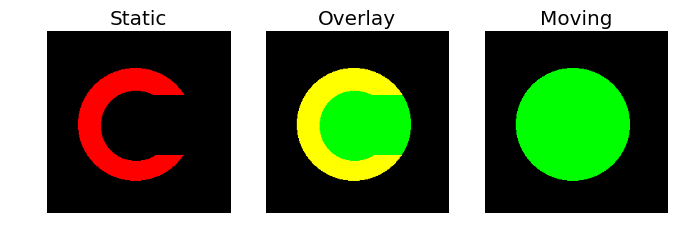Overview
Teaching: 15 min Exercises: 0 minQuestions
How do we register images of brains?
Objectives
Understand what the SyN algorithm does to images
Another operation that we often want to do with neuroimages is registration. We may want to register different images of the same brain to each other, or images of different brains.
Though there are many algorithms to perform this registration, and your motivations in selecting an algorithm may depend on what exactly it is that you are trying to do, but one algorithm that is successful in many situations, and has had success in formal conparisons is the Symmetric Normalization (SyN) algorithm ([Avants et al. 2009 (http://www.ncbi.nlm.nih.gov/pubmed/17659998)).
Though the canonical implementation of the algorithm is in the ANTS Here, we’ll use the implementation of the SyN algorithm in Dipy to understand a bit about what it does.
One of the strengths of the algorithm, that differentiates it from other algorithms, is that instead of calculating a linear homogenous transform between a moving image and a static image, the SyN algorithm calculates a deformation field. That means that different . The algorithm makes sure that the transformation is a diffeomorphism, which means that it is both invertible and smooth.
Let’s see what that looks like with a really simple example (based on an example in the Dipy documentation):
import numpy as np
from dipy.data import get_data
import dipy.align.imwarp as imwarp
from dipy.viz import regtools
fname_moving = get_data('reg_o')
fname_static = get_data('reg_c')
moving = np.load(fname_moving)
static = np.load(fname_static)
One of these will be defined as the image that moves and the other is the comparison image to which things will be moved.
The regtools module has a helper function to visualize the two images side by
side, together with an overlay:
regtools.overlay_images(static, moving, 'Static', 'Overlay', 'Moving', '../fig/reg_input_images.png')
[ ]
]
The diffeomorphism will be found through optimization. A cost metric needs to be defined to tell us whether we have found a good diffeomorphism.
The first decision we need to make is what similarity metric is appropriate for our problem. In this example we are using two binary images, so the Sum of Squared Differences (SSD) is a good choice (other options are cross-correlation and mutual information).
from dipy.align.metrics import SSDMetric
metric = SSDMetric(static.ndim)
Next, we define an instance of the registration class. The SyN algorithm uses a multi-resolution approach (essentially peforming the algorithm again and again from a coarse resolution down to a fine resolution). We instruct the registration instance to perform at most [n_0, n_1, …, n_k] iterations at each level of the pyramid, where the 0-th level corresponds to the finest resolution.
from dipy.align.imwarp import SymmetricDiffeomorphicRegistration
level_iters = [200, 100, 50, 25]
sdr = SymmetricDiffeomorphicRegistration(metric, level_iters, inv_iter = 50)
To execute the optimization, we call this registration object with our moving
and static input images
~~~
mapping = sdr.optimize(static, moving)
~~~
To visualize the diffeomorphism, we can visualize the forward and inverse transform encoded in the mapping
regtools.plot_2d_diffeomorphic_map(mapping, 10,
'../fig/reg_diffeomorphic_map.png')
We can test the success of the algorithm, by applying the transform to the moving object:
warped_moving = mapping.transform(moving)
regtools.overlay_images(static, warped_moving, 'Static','Overlay',
'Warped moving', '../fig/reg_direct_warp_result.png')
The inverse transform can be used to go from the static to the moving image:
warped_static = mapping.transform_inverse(static, 'linear')
regtools.overlay_images(warped_static, moving,
'Warped static','Overlay','Moving',
'inverse_warp_result.png')
Now that we understand the principal, let’s do this in practice on some brain data. In this case, we’ll use the data-sets that ship with Dipy. These are data-sets from the brains of two different individuals:
On the first run of this, it will automatically download the data:
from dipy.data import fetch_stanford_hardi, read_stanford_hardi
fetch_stanford_hardi()
nib_stanford, gtab_stanford = read_stanford_hardi()
stanford_b0 = np.squeeze(nib_stanford.get_data())[..., 0]
from dipy.data.fetcher import fetch_syn_data, read_syn_data
fetch_syn_data()
nib_syn_t1, nib_syn_b0 = read_syn_data()
syn_b0 = np.array(nib_syn_b0.get_data())
To make the segmentation go better, we start by stripping the skull. median_otsu is an example of an image-processing pipeline: it iteratively applies a local median filter, coupled with the Otsu algorithm we saw before:
from dipy.segment.mask import median_otsu
stanford_b0_masked, stanford_b0_mask = median_otsu(stanford_b0, 4, 4)
syn_b0_masked, syn_b0_mask = median_otsu(syn_b0, 4, 4)
static = stanford_b0_masked
static_affine = nib_stanford.get_affine()
moving = syn_b0_masked
moving_affine = nib_syn_b0.get_affine()
The SyN algorithm works much better if the brains are pre-aligned using a linear approach (e.g., a an affine transformation). This transform will do:
pre_align = np.array([[1.02783543e+00, -4.83019053e-02, -
6.07735639e-02, -2.57654118e+00],
[4.34051706e-03, 9.41918267e-01,
-2.66525861e-01, 3.23579799e+01],
[5.34288908e-02, 2.90262026e-01,
9.80820307e-01, -1.46216651e+01],
[0.00000000e+00, 0.00000000e+00,
0.00000000e+00, 1.00000000e+00]])
from dipy.align.imaffine import AffineMap
affine_map = AffineMap(pre_align,
static.shape, static_affine,
moving.shape, moving_affine)
resampled = affine_map.transform(moving)
As before, we visualize the two images: ~~~ regtools.overlay_slices(static, resampled, None, 1, ‘Static’, ‘Moving’, ‘../fig/reg_input_3d.png’) ~~~
Here, we will use the cross-correlation between the images as the metric.:
from dipy.align.metrics import CCMetric
metric = CCMetric(dim=3)
Again, we allocated the registration object:
level_iters = [10, 10, 5]
sdr = SymmetricDiffeomorphicRegistration(metric, level_iters)
and optimize it:
mapping = sdr.optimize(static, moving, static_affine, moving_affine, pre_align)
The moving image is transformed towards the static image: ~~~ warped_moving = mapping.transform(moving) ~~~
Considering that these are two different brains, it looks pretty good!
regtools.overlay_slices(static, warped_moving, None, 1, 'Static',
'Warped moving', '../fig/reg_warped_moving.png')
Key Points
The SyN algorithm is a powerful algorithm for calculating diffeomorphic transformations between images
It’s particularly useful for registering images of brains